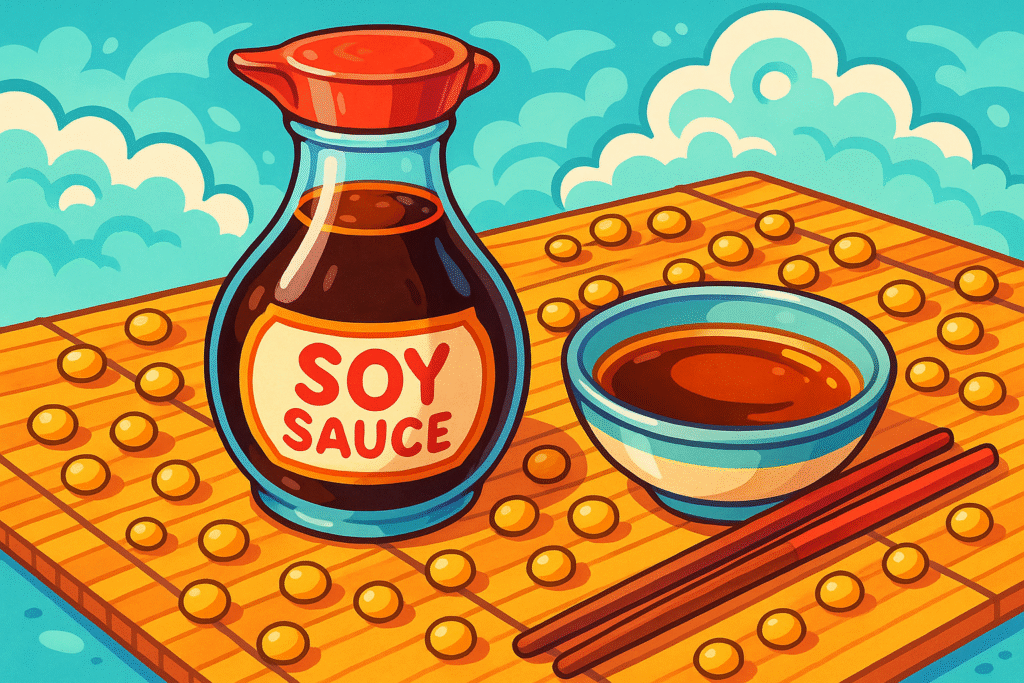Soy Sauce ()

About Soy Sauce
Soy sauce, derived from the fermentation of soybeans (Glycine max) and wheat, is a pillar of East Asian cooking cherished for its intricate, umami-driven flavor. With a taste profile that balances salty, savory, and subtle sweet notes, soy sauce brings depth to everything from sushi and stir-fries to dipping sauces and marinades. Its distinctive aroma, inky color, and complex savoriness come from a process perfected over centuries. Beyond just enhancing saltiness, soy sauce delivers that elusive fifth taste — umami — and a world of possibilities across Japanese, Chinese, Korean, Southeast Asian, and even global fusion dishes.
The History of Soy Sauce
The roots of soy sauce run deep, tracing back over 2,200 years to ancient China, where it evolved from fermented pastes of fish and grains known as jiang. By the Han dynasty, methods specifically using soybeans and wheat produced what we recognize as soy sauce today. The technique spread to Japan in the 7th century, leading to the development of shoyu. Throughout Korea, Vietnam, Indonesia, and beyond, each region adapted the recipe with local ingredients, shaping its own signature style. Over time, soy sauce not only became a kitchen essential but also a reflection of culinary identity and ritual — poured onto tofu in Kyoto, infused in Korean jjajangmyeon, or stirred into Southeast Asian satays. Its journey speaks to ingenuity and cultural adaptation.
The Science of Soy Sauce
Soy sauce’s signature punch comes from an intricate fermentation process. Koji mold (Aspergillus oryzae) is first introduced to cooked soybeans and wheat, breaking down starches and proteins. This moromi mash ferments for several months to years, generating glutamates (responsible for umami), aromatic acids, sugars, and hundreds of trace flavor compounds. Chemically, real soy sauce is remarkably complex, with about 300 different aromatic molecules. It’s also low in fat and, while high in sodium, contains antioxidant peptides and minerals. Traditional brewing methods retain beneficial bacterial activity, while chemically produced sauces (common in mass-produced versions) skip fermentation for speed but lose much of the signature depth.
The Geography of Soy Sauce
Soy sauce is most closely associated with East and Southeast Asia, but its nuances change with geography. In Japan, brewing conditions and local water lend a slightly sweet, mellow taste to shoyu. Chinese soy sauces vary widely by region — northern varieties tend to be saltier and more assertive, while southern types are lighter and offer a hint of caramel. Korea’s ganjang often uses only soybeans and brine, creating a clear, robust soy sauce that’s a staple in temple cooking. Across Indonesia and Southeast Asia, soy sauce can be thickened with palm sugar or spiced, reflecting regional culinary flourishes. Geographic differences in soybeans, wheat, fermentation time, and climate give rise to unique identities and applications.
Varieties of Soy Sauce
Shoyu (Japanese Soy Sauce)
Light-bodied with a gently sweet, umami-forward flavor — thanks to a balanced use of soybeans and wheat. Central to Japanese cuisine in dishes from sashimi dips to ramen broths.
Usukuchi
A pale, saltier Japanese soy sauce. While lighter in color, it brings a stronger salinity, making it ideal for simmered dishes where ingredients’ colors should shine through.
Koikuchi
The classic, all-purpose Japanese soy sauce — dark, richly flavored, and versatile. Approximately 80% of Japanese soy sauce production is koikuchi.
Tamari
The wheat-free alternative, traditionally a byproduct of miso. It is thicker and darker, with a cleaner, less sweet taste, often used in gluten-free recipes or for drizzling over tofu.
Chinese Light Soy Sauce (Shēng chōu)
Thin, reddish-brown, and intensely salty, this is the go-to for seasoning and marinades across southern China and Cantonese cooking.
Chinese Dark Soy Sauce (Lǎo chōu)
Aged with added molasses or caramel, resulting in a darker, sweeter, and thicker sauce. Usually used to deepen color and flavor in braised dishes.
Korean Ganjang
Clear-brown, robust, and punchy, often brewed without wheat. Used both as a table condiment and crucial ingredient in dishes like bulgogi or kimchi-jjigae.
Indonesian Kecap Manis
A syrupy, sweet soy sauce made with generous amounts of palm sugar. Staples in Indonesian satay, nasi goreng, and as a glaze.
FAQs All your questions about Soy Sauce: answered
Is all soy sauce gluten-free?
Not always. Traditional soy sauce is brewed with wheat. However, tamari and some artisanal or labeled gluten-free versions are made without wheat, making them safe for gluten-sensitive individuals.
How long does soy sauce last after opening?
Soy sauce is naturally shelf-stable thanks to its salt content. Once opened, it’s best stored in a cool, dark place or refrigerated, where it will maintain peak flavor for 6 months to a year, though it remains safe to use much longer.
Can I substitute light and dark soy sauce freely?
Light and dark soy sauces have distinct flavors, colors, and culinary roles. Light soy sauce is saltier and for seasoning; dark soy sauce is richer and for color. Swapping them in recipes can alter taste and appearance, so it’s best to use what’s called for or adjust quantities thoughtfully.
Why does traditional soy sauce taste better than mass-produced versions?
Traditionally brewed soy sauce ferments slowly, developing deep, complex flavors thanks to live cultures and natural aging. Chemically produced soy sauces, made quickly using acid hydrolysis, lack these subtle notes and often taste overtly salty or harsh.
What are the health benefits and drawbacks of soy sauce?
Soy sauce is rich in umami and contains beneficial antioxidants, but it is high in sodium, so it should be used in moderation. Naturally brewed soy sauces offer enzymes and compounds not found in synthetic versions.